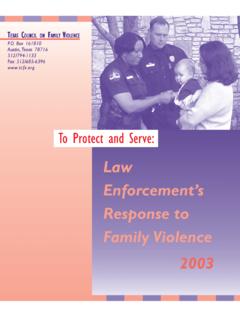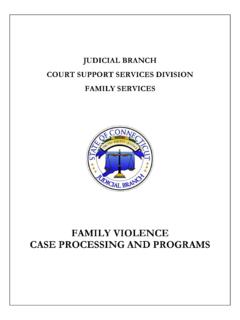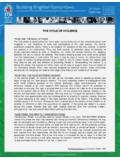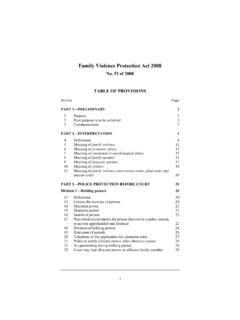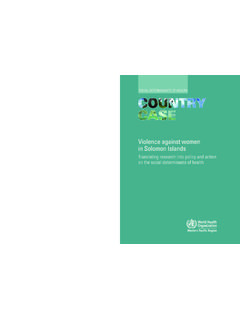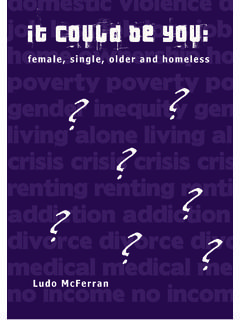Transcription of Theoretical Basis for Family Violence
1 5 Chapter 2 Theoretical Basis forFamily Violence Maren E. Hyde-Nolan, PhDTracy Juliao, PhDINTRODUCTIONA number of different psychological theories address the causes of Family vi-olence (FV). The most popular theories all acknowledge the abuse of powerand control by the abusers, although the role of power and control varies bytheoretical orientation. In this chapter, we focus on four main Theoretical cat-egories: (1) psychoanalytic theories of FV, (2) social theories of FV, (3) cog-nitive behavioral theories of FV, and (4) Family and systems theories of theories focus on individual internal psychological processesthat create a need to be abusive or to accept abusive behavior.
2 Social theoriesfocus on how aggression, abuse, and Violence are learned and transferred byindividual members of the Family to others within the Family . Cognitive be-havior theories also focus on how aggression, abuse, and Violence are learnedand transferred among individuals, but these theories further attempt toexplain why abusive behaviors are sometimes transmitted from generationto generation while other times they are not. Finally, Family and systems the-ories focus on the interactions between Family members and the shared re-sponsibility for the events that occur within the Family theories of FV have been left out of the review in this chapter, so wewill brief ly mention a few of them here.
3 For instance, the feminist perspec-tive regarding FV focuses on patriarchal societies that foster a patriarchalfamily structure in which men are expected to have power over 12/15/10 12:55 PM Page 5 Jones & Bartlett Learning, LLC. NOT FOR SALE OR DISTRIBUTIONS imilarly, historical and ecological approaches to FV suggest that violenceagainst women and children has always been present, noting that certaingroups become targets within certain , although there arevarious cultural theories of FV,3 7we have decided to conceptualize cul-tural considerations as an overarching umbrella under which all other the-ories of FV fall.
4 In other words, it is impossible to understand FV in theabsence of a cultural understanding of the individuals involved in the be-haviors in THEORIES OF Family VIOLENCET hree psychodynamic theories are discussed: object relations theory, at-tachment theory, and a theory called Violence as Relations TheoryObject relations theory suggests that humans are motivated from their ear-liest childhood by the need for significant relationships with others;8 oth-ers are referred to as objects within objects relations theory. To reduce thepotential for confusion, we simply refer to objects as others or other in-dividuals in this chapter.
5 Fairbairn8suggests that these early relationships,in addition to playing a role in psychic development, form the enduringpsychological templates for all of the individual s future relationships. Inessence, object relations theory proposes that individuals develop mentalrepresentations of themselves, other individuals, and the relationships be-tween themselves and others beginning in infancy and childhood; thesemental representations carry over and inf luence interpersonal relationshipsthroughout 11 Many prominent object relations theorists suggest thatthe child s early experiences in his or her relationship with the primary care-giver set the stage for the development of stable, enduring, internalizedmental representations of oneself, others.
6 And the emotional experiencesthat are attached to the relationship between the oneself and 16 The first years of life are extremely important for individuals to ensure thedevelopment of adequate emotional health in later wholacked sufficient nurturing during infancy and childhood may find it dif-ficult to maintain healthy self-esteem, regulate their emotional responses,and manage anxiety in later life. Unmet dependency needs in childhoodpersist into adulthood, often accompanied by a sense of rage that one s needswere not met. As a result, the search to fulfill dependency needs as an adultbecomes both desperate and demanding,1which could lead to relationshipsin which one is either an abuser or a ,10,17,18 For example, evidenceChapter 2: Theoretical Basis for Family 12/15/10 12:55 PM Page 6 Jones & Bartlett Learning, LLC.
7 NOT FOR SALE OR DISTRIBUTION suggests that at least some men who commit intimate partner Violence (IPV)did not receive adequate nurturing in the first years of ,17 Duttonet al18found that becoming an adult perpetrator of IPV was significantly cor-related with Violence in the Family of origin, as well as with parental contrast, it has been argued that individuals who become victims of violencein adolescent and/or adult relationships, and who continue to maintain thoserelationships despite the Violence , do so because of internal defenses that are em-ployed during early development in an abusive, neglectful, or inconsistent re-lationship with the primary ,10.
8 17 The development and utilization ofdefenses during infancy and childhood is highly adaptive, in that doing so allows for survival within an abusive Family , when thesedefenses are carried over into adolescent or adult relationships, they are mal-adaptive and prevent the individual from effectively recognizing the presence orabsence of abuse in relationships and further promote maintenance of a rela-tionship with someone who resembles the abusive primary caretaker from infancy and ,10 Attachment TheoryUnlike the emphasis placed on the individual s mental representation of arelationship in the object relations theory, attachment theory emphasizesreciprocity between individuals within a relationship.
9 Attachment is definedas a reciprocal, enduring emotional tie between an infant and a caregiver, withboth parties actively contributing to the quality of the to the early attachment theorists, Bowlby20and Ainsworth,21an in-fant develops a working model of what can be expected from his or her pri-mary caregiver. If the caregiver continues to respond in expected ways, theinfant s model holds up; however, if the caregiver s responses become con-sistently unpredictable, the infant is forced to revise his or her model, andthe security of the attachment basic concept underlying thetheory of attachment is that adults have the power to both protect and pro-vide a sense of security for their children.
10 At times when the child feels threat-ened, exhausted, or ill, he or she will turn to the caregiver for security the attachment bond is formed, it ensures that the securebase of the relationship is in place. One of the key features of such a securebase is the relationship between security and exploration. A child with secureattachment can explore the environment, but when the child feels threat-ened, attachment behaviors are activated, and the child will seek out the se-cure build a representation of their own worthinessbased on their experiences and perceptions of the caregiver s ability, avail-ability, and willingness to provide care and time the childPsychodynamic Theories of Family 12/15/10 12:55 PM Page 7 Jones & Bartlett Learning, LLC.











